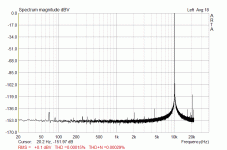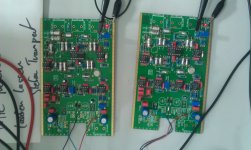Valeriano,
For the ADC board, i can organize a group-buy but i'm not shure that enough DIYers would be interested. It's a 4 layers PCB, the price (including worldwide shipping) would be about 40€ each if at least 5 PCB are ordered.
If enough people ask me (by PM), i would open wiki page for a PCB group buy.
Regards.
Frex
For the ADC board, i can organize a group-buy but i'm not shure that enough DIYers would be interested. It's a 4 layers PCB, the price (including worldwide shipping) would be about 40€ each if at least 5 PCB are ordered.
If enough people ask me (by PM), i would open wiki page for a PCB group buy.
Regards.
Frex
Hello Valeriano,
Yes, i will provide many files, including bom, schematics , full CPLD project files, datasheets, mechanical drawing, and many more others. I will post some of these files on the wiki page very soon.
Regards.
Frex
Yes, i will provide many files, including bom, schematics , full CPLD project files, datasheets, mechanical drawing, and many more others. I will post some of these files on the wiki page very soon.
Regards.
Frex
Hey Guys,
The BOM includes some polystyrene caps (C54, C57, C58) with a value of 'NC'. What does that 'NC' mean?
Cheers,
Dave.
The BOM includes some polystyrene caps (C54, C57, C58) with a value of 'NC'. What does that 'NC' mean?
Cheers,
Dave.
Hello dfidler,
NC is "Not Connected".
These free footprints allow to use parrallels combinations with many capacitors, in order to obtain a precise output frequency.
Regards.
Frex.
NC is "Not Connected".
These free footprints allow to use parrallels combinations with many capacitors, in order to obtain a precise output frequency.
Regards.
Frex.
Frex, one more question if you don't mind.
On the schematic for the ultra low THD oscillator, you listed the ESR for C34, C35, (2.2uF) C5 (4.7uF) and C24, C33 (10uF) capacitors. Is it critical to match that ESR?
In other words, will a tantalum or another type of solid cap work instead?
Thanks again for your help.
On the schematic for the ultra low THD oscillator, you listed the ESR for C34, C35, (2.2uF) C5 (4.7uF) and C24, C33 (10uF) capacitors. Is it critical to match that ESR?
In other words, will a tantalum or another type of solid cap work instead?
Thanks again for your help.
gray5596,
The capacitors you're talking about can be replaced without any issue with electrolytic capacitors. If it possible, use a low esr type.
Frex.
The capacitors you're talking about can be replaced without any issue with electrolytic capacitors. If it possible, use a low esr type.
Frex.
Hello,
About the ultra-low THD 10kHz oscillator, i still have some printed circuit boards available, interested DIYers can contact me by PM. The price still the same of 30€/1 including the worldwide shipping.
Regards. 🙂
Frex.
About the ultra-low THD 10kHz oscillator, i still have some printed circuit boards available, interested DIYers can contact me by PM. The price still the same of 30€/1 including the worldwide shipping.
Regards. 🙂
Frex.
Hello,
Yes, some bare PCB are available for sale.
30€ each, including worldwide shipping.Paypal only.
Complete design folder send by e-mail to all buyer as
soon payment done.
Frex
Yes, some bare PCB are available for sale.
30€ each, including worldwide shipping.Paypal only.
Complete design folder send by e-mail to all buyer as
soon payment done.
Frex
Hello Clemens,
Yes, bare pcb's are available, but i'm actually in holidays, and i come back in ten days.
Please, send me your e-mail address by PM and i will send you a Paypal invoice for 2 circuit boards(60€).
So you can make the payment when i'll be back.
The full design folder will be also send as soon the payment is done.
Regards.
Frex
Yes, bare pcb's are available, but i'm actually in holidays, and i come back in ten days.
Please, send me your e-mail address by PM and i will send you a Paypal invoice for 2 circuit boards(60€).
So you can make the payment when i'll be back.
The full design folder will be also send as soon the payment is done.
Regards.
Frex
Design folder
Frex,
I purchased my board from you last year, I have not gotten around to build it yet but just released I lost my copy of the "design folder" when my hard drive died. Can you send me the file again and I will burn it for offline storage.
Thanks
Bill
Frex,
I purchased my board from you last year, I have not gotten around to build it yet but just released I lost my copy of the "design folder" when my hard drive died. Can you send me the file again and I will burn it for offline storage.
Thanks
Bill
I finished 3 of those boards a few months ago.
I noticed a few "strange" things, that you should take care of.
1) If you are not using Frex regulator, do not exeed +-10.5V. It's not a problem of destroying a component. On my boards the THD turns instantly bad.
2) The version on 3Khz does not have the same performance than the version on 10Khz. Even with a moded stability network around the opamps.
3)Both 10Khz Versions had some stability issues. I wondered, that sometimes the THD was bad turning the board on, and sometimes it was good. The oszillating was only viewable on a very good scope. With my finger as a RCL Network i found the "failure". Both failures were on the controlled side (by the way, the K2 is much more visible on this side). On one board, i lowered one resistor, on the other board i had to put a very small trimm cap on one output (it was very strange, sometimse the scope probe was enought to get it stable).
On all of my tests I used very gut powersupplies from Funk Audio (with 80€ a little bit expensive but every penny worth!).
I compared the oszillator with the Rhode und Schwarz UPV. It was not possible to see any K3 on the screen. With the internal osz. was less noisy. I'll search for the screenshot again.
I noticed a few "strange" things, that you should take care of.
1) If you are not using Frex regulator, do not exeed +-10.5V. It's not a problem of destroying a component. On my boards the THD turns instantly bad.
2) The version on 3Khz does not have the same performance than the version on 10Khz. Even with a moded stability network around the opamps.
3)Both 10Khz Versions had some stability issues. I wondered, that sometimes the THD was bad turning the board on, and sometimes it was good. The oszillating was only viewable on a very good scope. With my finger as a RCL Network i found the "failure". Both failures were on the controlled side (by the way, the K2 is much more visible on this side). On one board, i lowered one resistor, on the other board i had to put a very small trimm cap on one output (it was very strange, sometimse the scope probe was enought to get it stable).
On all of my tests I used very gut powersupplies from Funk Audio (with 80€ a little bit expensive but every penny worth!).
I compared the oszillator with the Rhode und Schwarz UPV. It was not possible to see any K3 on the screen. With the internal osz. was less noisy. I'll search for the screenshot again.
Here is mine....
I finished mine a few months ago and this is what I got. Measured with Xonar Essence STX sound card. The only problem I have is that the other non-sym output has higher THD and I don't know why. THD on other output is around 0.004 or something like that, I don't remember the exact number. I am showing the good output.
I finished mine a few months ago and this is what I got. Measured with Xonar Essence STX sound card. The only problem I have is that the other non-sym output has higher THD and I don't know why. THD on other output is around 0.004 or something like that, I don't remember the exact number. I am showing the good output.
Attachments
Last edited:
0.004% is around -84db? That is exactly what i measured with the instable ones too.
So try to find the "bug" with the power of your LCR Finger.
Stefan
I found out, that its not a good use a symetrical output with a bnc socket, because the osz. is getting unstable sometimes. I would use a mini XLR socket ore something simmilar.
I boulded up a twin T Notch filter with two different trimmers (for 0.2% and 0.02%) and got around -100db of fundamental suprression. This couple is ideal for amplifier measurements, because you can use your soundcard for measurements around 35v pp.
So try to find the "bug" with the power of your LCR Finger.
Stefan
I found out, that its not a good use a symetrical output with a bnc socket, because the osz. is getting unstable sometimes. I would use a mini XLR socket ore something simmilar.
I boulded up a twin T Notch filter with two different trimmers (for 0.2% and 0.02%) and got around -100db of fundamental suprression. This couple is ideal for amplifier measurements, because you can use your soundcard for measurements around 35v pp.
Attachments
Last edited:
I've finally got round to building my 10kHz oscillator, and am struggling with stability too. I'm using Frex's power supply and have all 3x BNC connectors installed. I can get it to oscillate without saturation, but it's very load dependent and doesn't start reliably. The best I can get 2nd harmonic at about -85db, but there's lots of 1.5MHz and 85MHz noise on the signal. Finger 'LCR' can start the oscillator and change its amplitude, but I've not found a way to tame it to get a good looking signal. Has anyone got any advice on where to start looking? Thanks!
This thing is sensitive to adjust, it took me a while to tune it up. I had a small window on a trimpot for oscillation. Amplitude adjustment was no problem. The final part about second harmonic distortion adjustment described at AN67 note didn't work for me. I found it impossible to adjust THD on LT1228 output using my audio card (since I don't have spectrum analyser). I adjusted THD with one of the output connected to my ASUS card as the whole thing. Also, sometimes, it fails to start. I think power supply is very important. I hope you used at least LMxxxx pre regulators before the Frex' zenner regulator.
- Status
- Not open for further replies.
- Home
- diyaudio.com Wiki
- [3rd round] AN67 Ultra-low THD 10kHz sine oscillator PCB Group buy.

